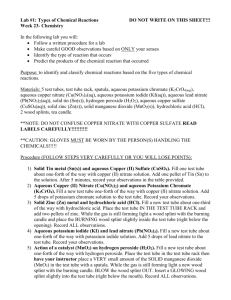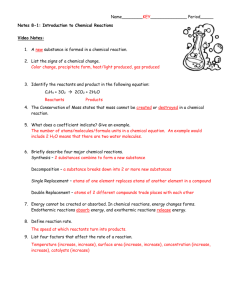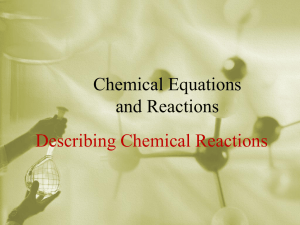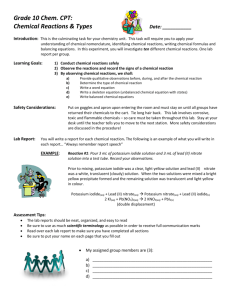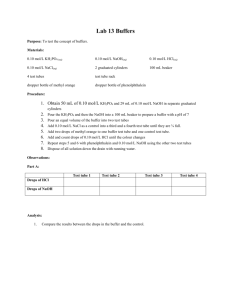Unit 2 Lab - Chemical Reactions - SchoolWorld an Edline Solution
advertisement
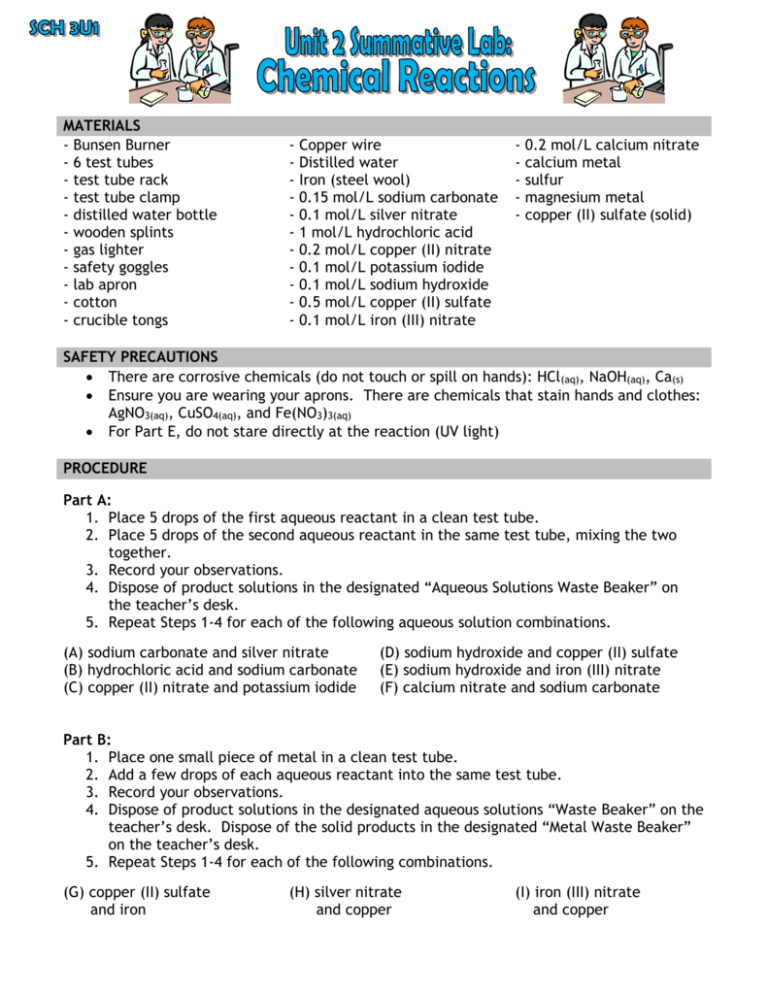
MATERIALS - Bunsen Burner - 6 test tubes - test tube rack - test tube clamp - distilled water bottle - wooden splints - gas lighter - safety goggles - lab apron - cotton - crucible tongs - Copper wire Distilled water Iron (steel wool) 0.15 mol/L sodium carbonate 0.1 mol/L silver nitrate 1 mol/L hydrochloric acid 0.2 mol/L copper (II) nitrate 0.1 mol/L potassium iodide 0.1 mol/L sodium hydroxide 0.5 mol/L copper (II) sulfate 0.1 mol/L iron (III) nitrate - 0.2 mol/L calcium nitrate calcium metal sulfur magnesium metal copper (II) sulfate (solid) SAFETY PRECAUTIONS There are corrosive chemicals (do not touch or spill on hands): HCl(aq), NaOH(aq), Ca(s) Ensure you are wearing your aprons. There are chemicals that stain hands and clothes: AgNO3(aq), CuSO4(aq), and Fe(NO3)3(aq) For Part E, do not stare directly at the reaction (UV light) PROCEDURE Part A: 1. Place 5 drops of the first aqueous reactant in a clean test tube. 2. Place 5 drops of the second aqueous reactant in the same test tube, mixing the two together. 3. Record your observations. 4. Dispose of product solutions in the designated “Aqueous Solutions Waste Beaker” on the teacher’s desk. 5. Repeat Steps 1-4 for each of the following aqueous solution combinations. (A) sodium carbonate and silver nitrate (B) hydrochloric acid and sodium carbonate (C) copper (II) nitrate and potassium iodide (D) sodium hydroxide and copper (II) sulfate (E) sodium hydroxide and iron (III) nitrate (F) calcium nitrate and sodium carbonate Part B: 1. Place one small piece of metal in a clean test tube. 2. Add a few drops of each aqueous reactant into the same test tube. 3. Record your observations. 4. Dispose of product solutions in the designated aqueous solutions “Waste Beaker” on the teacher’s desk. Dispose of the solid products in the designated “Metal Waste Beaker” on the teacher’s desk. 5. Repeat Steps 1-4 for each of the following combinations. (G) copper (II) sulfate and iron (H) silver nitrate and copper (I) iron (III) nitrate and copper Part C: 1. Measure a scoopula tip of solid copper (II) sulfate pentahydrate into a clean dry test tube. 2. Using a test tube holder, hold the test tube and contents at an angle away from yourself and any of your classmates. 3. Using a Bunsen burner, heat the test tube gently over the Bunsen burner until no further change is noticed. (Reaction J) 4. Turn off the Bunsen burner and let the solid cool for approximately 2-3 minutes. 5. Use a distilled water bottle to add 3 or 4 drops of water to the test tube. Note any observations. (Reaction K) Part D (Reaction L): 1. Place a small scoopula tip full of sulfur and one piece of calcium into a clean dry test tube. 2. Place a cotton plug at the top of the test tube. 3. Heat vigorously over the Bunsen burner. 4. Note any observations. Part E (Reaction M and N): 1. Take a small piece of magnesium and burn the small piece of magnesium directly in the Bunsen burner flame using a pair of crucible tongs. 2. Place the burned product on an evaporating dish. 3. Note any observations. 4. Add 5 mL of distilled water to the previous product and stir with the end of a glass stirring rod. 5. Add two drops of phenolphthalein to the mixture. 6. Note any observations EVALUATION Laboratory Instructions: Complete the following charts by observing the chemical reactions. Include observations of the reactants and products (describe using chemical and physical properties), indicate which clues of a chemical reaction you observed (be specific), write a chemical skeletal equation for the reaction, write a balanced chemical equation for the reaction and finally indicate the type of reaction that has occurred. If there is a more specific kind of reaction, please specify it. Reaction Category Descriptor Part A Thinking and Investigation /12 Communication /18 Part B Thinking and Investigation /6 Communication /9 Part C Thinking and Investigation /4 Communication /6 Parts D and E Thinking and Investigation /8 Communication /12 Mark Physical Properties of Reactants and Products Evidence of Chemical Reaction 0 1 2 3 4 5 6 0 1 2 3 4 5 6 0 0 0 1 1 1 2 2 2 3 3 3 4 4 4 5 6 5 6 5 6 Word Equation Balanced Chemical Equation Type of Chemical Reaction Physical Properties of Reactants and Products Evidence of Chemical Reaction 0 1 2 3 0 1 2 3 0 0 0 1 1 1 2 2 2 3 3 3 Word Equation Balanced Chemical Equation Type of Chemical Reaction Physical Properties of Reactants and Products Evidence of Chemical Reaction 0 1 2 0 1 2 0 0 0 1 1 1 2 2 2 Word Equation Balanced Chemical Equation Type of Chemical Reaction Physical Properties of Reactants and Products Evidence of Chemical Reaction 0 1 2 3 4 0 1 2 3 4 0 0 0 1 1 1 2 2 2 3 3 3 4 4 4 Word Equation Balanced Chemical Equation Type of Chemical Reaction TOTAL MARK: Thinking and Investigation Communication /30 /45


